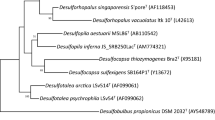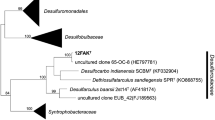Abstract
A moderately thermophilic, sulphate-reducing bacterium, designated strain P6-2T, was isolated from a terrestrial hot spring located at a height of 2,500 m in the Andean region, Colombia (5°43′69″N, 73°6′10″W). Cells of strain P6-2T were rod-shaped, stained Gram-negative and were motile by means of a single polar flagellum. The strain grew lithotrophically with H2 as the electron donor and organotrophically on lactate, pyruvate, ethanol, malate, fumarate, n-propanol and succinate in the presence of sulphate as the terminal electron acceptor. Fumarate and pyruvate was fermented. Strain P6-2T grew optimally at 55°C (range 37–60°C), pH 6.6 (range 5.8–8.8) in the presence of 0.5% NaCl (range 0–4.5%) with lactate and sulphate and produced acetate, CO2 and H2S as the major end-products. Sulphate, sulphite and thiosulphate could be used as electron acceptors but not elemental sulphur or nitrate. The G + C content of the genomic DNA was 58.7 mol%. The 16S rRNA sequence analysis indicated that strain P6-2T was a member of the class Deltaproteobacteria, domain Bacteria with Desulfomicrobium baculatum being the closest relative (similarity value of 94%). Phylogeny of genes encoding α- and β-subunits of the dissimilatory sulphite reductase (dsrAB genes) supported its affiliation to members of the genus Desulfomicrobium. On the basis of this evidence, we propose to assign strain P6-2T as new species of the genus Desulfomicrobium, D. thermophilum sp. nov., with strain P6-2T as the type strain (= DSM 16697T = CCUG 49732T).




Similar content being viewed by others
References
Audiffrin C, Cayol JL, Joulian C, Casalot L, Thomas P, Garcia JL, Ollivier B (2003) Desulfonauticus submarinus gen. nov., sp. nov., a novel sulfate-reducing bacterium isolated from a deep-sea hydrothermal vent. Int J Syst Evol Microbiol 53:1585–1590
Balch CM, Fox GE, Magrum RJ, Wolfe RS (1979) Methanogens: reevaluation of a unique biological group. Microbiol Rev 43:260–296
Beeder J, Torsvik T, Lien T (1995) Thermodesulforhabdus norvegicus gen. nov. sp. nov., a novel thermophilic sulfate-reducing bacterium from oil field water. Arch Microbiol 164:331–336
Benson D, Boguski MS, Lipman DJ, Ostell J, Ouellette BF, Rapp BA, Wheeler DL (1999) GenBank. Nucleic Acids Res 27:12–17
Blank CE, Cady SL, Pace N (2002) Microbial composition of near-boiling silica-depositing thermal springs throughout Yellowstone National Park. Appl Environ Microbiol 68:5123–5135
Castro HF, Williams NR, Ogram A (2000) Phylogeny of sulfate-reducing bacteria. FEMS Microbiol Ecol 31:1–9
Chang YJ, Peacock AD, Long PD, Stephen JR, McKinley JP, MacNaughton SJ, Anwar Hussain AKM, Saxton AM, White DC (2001) Diversity and characterization of sulfate-reducing bacteria in groundwater at a uranium mill tailings site. Appl Environ Microbiol 67:3149–3160
Cord-Ruwisch R (1985) A quick method of determination of dissolved and precipitated sulfides in cultures of sulphate-reducing bacteria. J Microbiol Methods 4:33–36
Fardeau ML, Patel BKC, Magot M, Ollivier B (1997) Utilization of serine, leucine, isoleucine, and valine by Thermoanaerobacter brockii in the presence of thiosulphate or Methanobacterium sp. as electron acceptors. Anaerobe 3:405–410
Fardeau ML, Magot M, Patel BKC, Thomas P, Garcia JL, Ollivier B (2000) Thermoanaerobacter subterraneus sp. nov., a novel thermophile isolated from oilfield water. Int J Syst Evol Microbiol 50:2141–2149
Fauque G, Ollivier B (2004) Anaerobes: the sulfate-reducing bacteria as an example of metabolic diversity. In: Bull AT (ed) Microbial diversity and prospecting. ASM, Washington, pp 169–176
Felsenstein J (1993) PHYLIP (Phylogenetic Inference Package) version 3.51c. Distributed by the author. Department of Genetics, University of Washington, Seattle
Ferris ML, Magnuson TS, Fagg JA, Thar R, Kühl M, Sheehan KB, Henson JM (2003) Microbially mediated sulfide production in a thermal acidic algal mat community in Yellowstone National Park. Environ Microbiol 5:954–960
Fishbain S, Dillon JG, Gough HL, Stahl DA (2003) Linkage of high rates of sulfate reduction in yellowstone hot springs to unique sequence types in the dissimilatory sulfate respiration pathway. Appl Environ Microbiol 69:3663–3667
Goorissen HP, Boschker HTS, Stams AJM, Hansen TA (2003) Isolation of thermophilic Desulfotomaculum strains with methanol and sulfite from solfataric mud pools, and characterization of Desulfotomaculum solfataricus sp. nov. Int J Syst Evol Microbiol 53:1223–1229
Hall TA (1999) Bioedit: a user-friendly biological sequence alignment editor and analysis program for window 95/98/NT. Nucleic Acids Symp Ser 41:95–98
Henry EA, Devereux R, Maki JS, Gilmour CC, Woese CR, Mandelco L, Schauder L, Remsen CC, Mitchell R (1994) Characterization of a new thermophilic sulfate-reducing bacterium—Thermodesulfovibrio yellowstonii, gen. nov. and sp. nov.,—it’s phylogenetic relationship to Thermodesulfobacterium commune and their origins deep within the bacterial domain. Arch Microbiol 61:62–69
Hippe H, Vainshtein M, Gogotova GI, Stackebrandt E (2003) Reclassification of Desulfobacterium macestii as Desulfomicrobium macestii comb. nov. Int J Syst Evol Microbiol 53:1127–1130
Hugenholtz P, Pitulle C, Hershberger KL, Pace NR (1998) Novel division level bacterial diversity in a yellowstone hot spring. J Bacteriol 180:366–376
Itoh T, Suzuki K-I, Nakase T (1998) Thermocladium modestius gen. nov. sp. nov., a new genus of rod-shaped, extremely thermophilic crenarchaeote. Int J Syst Evol Microbiol 48:879–887
Itoh T, Suzuki K-I, Sanchez PC, Nakase T (1999) Caldivirga maquilingensis gen. nov., sp. nov., a new genus of rod-shaped crenarchaeote isolated from a hot spring in the Philippines. Int J Syst Bacteriol 49:1157–1163
Jukes TH, Cantor CR (1969) Evolution of proteins molecules. In: Murno HN (ed) Mammalian protein metabolism. Academic, New York, pp 21–132
Kimura M (1980) A simple model for estimating evolutionary rates of base substitutions through comparative studies of nucleotide sequences. J Mol Evol 16:111–120
Langendijk PS, Kulik EM, Sandmeier H, Meyer J, van der Hoeven JS (2001) Isolation of Desulfomicrobium orale sp. nov. and Desulfovibrio strain NY682, oral sulfate-reducing bacteria involved in human periodontal disease. Int J Syst Evol Microbiol 51:1035–1044
Liu Y, Karnauchow TM, Jarrell KF, Balkwill DL, Drake GR, Ringelberg D, Clarno R, Boone DR (1997) Description of two new thermophilic Desulfotomaculum spp., Desulfotomaculum putei sp. nov., from a deep terrestrial subsurface, and Desulfotomaculum luciae sp. nov, from a hot spring. Int J Syst Bacteriol 47:615–621
Love CA, Patel BKC, Nichols PD, Stackebrandt E (1993) Desulfotomaculum australicum, sp. nov., a thermophilic sulphate-reducing bacterium isolated from the Great Artesian Basin of Australia. Syst Appl Microbiol 16:244–251
Maidak BL, Cole JR, Lilburn TG, Parker CT Jr, Saxman PR, Farris RJ, Garrity GM, Olsen GJ, Schmidt TM, Tiedje JM (2001) The RDP-II (Ribosomal Database Project). Nucleic Acids Res 29:173–174
Mesbash M, Premachandran U, Whitman WB (1989) Precise measurement of the G+C content of deoxyribonucleic acid by high-performance liquid chromatography. Int J Syst Bacteriol 39:159–167
Meyer-Dombard DR, Shock EL, Amend JP (2005) Archaeal and bacterial communities in geochemically diverse hot springs of Yellowstone National Park, USA. Geobiology 3:211–227
Mori K, Kim H, Kakegawa T (2003) A novel lineage of sulfate-reducing microorganisms: Thermodesulfobiaceae fam. nov., Thermodesulfobium narugense, gen. nov. sp. nov., a new thermophilic isolate from a hot spring. Extremophiles 7:283–290
Postgate JR (1959) Cytochrome c3 and desulphoviridin; pigments of the anaerobe Desulfovibrio desulfuricans. J Gen Microbiol 14:545–572
Rees G, Grassia GS, Sheeny AJ, Dwivedi PP, Patel BKC (1995) Desulfacinum infernum gen. nov. sp. nov., a thermophilic sulfate-reducing bacterium from a petroleum reservoir. Int J Syst Bacteriol 45:85–89
Rozanova EP, Nazina TN (1976) A mesophilic, sulfate-reducing, rod shaped, nonsporeforming bacterium. Microbiology (English translation of Mikrobiologiya) 45:711–716
Rozanova EP, Nazina TN, Galushko AS (1988) Isolation of a new genus of sulfate reducing bacteria and description of a new species of this genus, Desulfomicrobium apsheronum gen. nov. sp. nov. Microbiology (English translation of Mikrobiologiya) 57:634–641
Rozanova EP, Nazina TN, Galushko AS (1994) Desulfomicrobium apsheronum gen. nov. sp. nov. in validation of the publication of new names and new combinations previously effectively published outside the IJSB. List No. 49. Int J Syst Bacteriol 44:370–371
Saitou N, Nei M (1987) The neighbor-joining method: a new method for reconstructing phylogenetic trees. Mol Biol Evol 4:406–425
Sharak Genthner BR, Mundfrom G, Devereux R (1994) Characterization of Desulfomicrobium escambium sp. nov. and proposal to assign Desulfovibrio desulfuricans Norway 4 to the genus Desulfomicrobium. Arch Microbiol 161:215–219
Sharak Genthner BR, Mundfrom G, Devereux R (1996) Desulfomicrobium escambiense sp nov. in validation of the publication of new names and new combinations previously effectively published outside the IJSB. List No. 59. Int J Syst Bacteriol 46:1189–1190
Sharak Genthner BR, Friedman SD, Devereux R (1997) Reclassification of Desulfovibrio desulfuricans Norway 4 as Desulfomicrobium norvegicum comb. nov. and confirmation of Desulfomicrobium escambiense (corrig., formerly “escambium”) as a new species in the genus Desulfomicrobium. Int J Syst Bacteriol 47:889–892
Sievert S, Kuever J (2000) Desulfacinum hydrothermale sp. nov., a thermophilic, sulfate-reducing bacterium from geothermally heated sediments near Milos Island (Greece). Int J Syst Evol Microbiol 50:1239–1246
Skirnisdottir S, Hreggvidsson OG, Hjörleifsdottir S, Marteinsson VT, Petursdottir SK, Holst O, Kristjansson JK (2000) Influence of sulfide and temperature on species composition and community structure of hot spring microbial mats. Appl Environ Microbiol 66:2835–2841
Sonne-Hansen J, Ahring BK (1999) Thermodesulfobacterium hveragerdense sp. nov., and Thermodesulfovibrio islandicus sp. nov., two thermophilic sulfate reducing bacteria isolated from an Icelandic hot spring. Syst Appl Microbiol 22:559–564
Stahl DA, Fishbain S, Klein M, Baker BJ, Wagner M (2002) Origins and diversification of sulfate-respiring microorganisms. Antonie Van Leeuwenhoek 81:189–195
Van de Peer Y, De Wachter R (1994) TREECON for windows: a software package for the construction and drawing of evolutionary trees for the Microsoft Windows environment. Comput Appl Biosci 10:569–570
Wagner M, Roger AJ, Flax JL, Brusseau GA, Stahl DA (1998) Phylogeny of dissimilatory sulfite reductases support an early origin of sulfate respiration. J Bacteriol 180:2975–2982
Zeikus JG, Dawson MA, Thompson TE, Ingvorsen K, Hatchikian CE (1983) Microbial ecology of volcanic sulphidogenesis: isolation and characterization of Thermodesulfobacterium commune gen. nov. and sp. nov. J Gen Microbiol 129:1159–1169
Acknowledgments
This work was supported by grants from IFS (International Foundation for Sciences), Instituto Colombiano para el Desarrollo de la Ciencia y la Tecnología (Colciencias) and Programa Ecos-Nord.
Author information
Authors and Affiliations
Corresponding author
Additional information
Communicated by K. Horikoshi.
Rights and permissions
About this article
Cite this article
Thevenieau, F., Fardeau, ML., Ollivier, B. et al. Desulfomicrobium thermophilum sp. nov., a novel thermophilic sulphate-reducing bacterium isolated from a terrestrial hot spring in Colombia. Extremophiles 11, 295–303 (2007). https://doi.org/10.1007/s00792-006-0039-9
Received:
Accepted:
Published:
Issue Date:
DOI: https://doi.org/10.1007/s00792-006-0039-9




